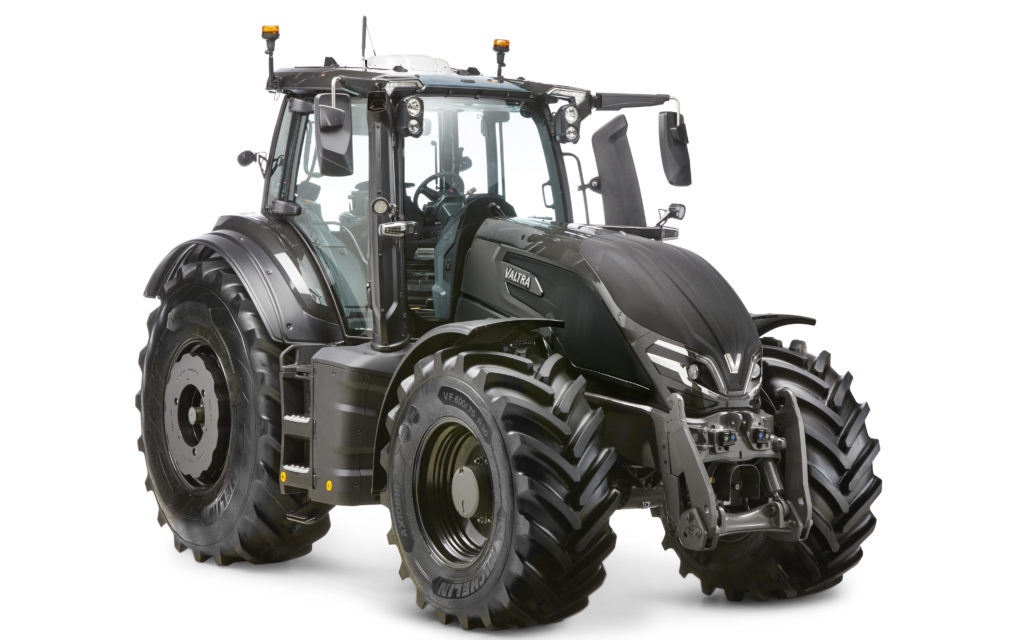Valtra has responded to the relentless increase in tractor power and specific demands of different agricultural sectors by introducing a further series of machines, which they have designated the ‘Q’ series.

There was, admittedly, something of a gap between the T and S series tractors, the former topping out at 235hp and the latter stepping in at 300hp; this gap is now well and truly plugged.
Power spread
There are five new models in the new Q series, providing a five horsepower overlap with the already existing tractors at either end of the range.
| Model | Rated hp | Rated Nm | Boosted hp | Boosted Nm |
|---|---|---|---|---|
| Q225 | 230 | 1000 | 250 | 1100 |
| Q245 | 245 | 1100 | 265 | 1200 |
| Q265 | 265 | 1200 | 290 | 1280 |
| Q285 | 285 | 1280 | 305 | 1280 |
| Q305 | 305 | 1280 | 305 | 1280 |
The 20hp increment between models offers a progressive increase in power from the six cylinder, 7.6L block which is fitted to all models.
Valtra highlights the fact that the engine is a long stroke unit which provides torque through extended leverage on the crankshaft, rather than relying on the larger piston surface area of more ‘square’ engine configurations.
CVT as standard
The company has taken the view that such are the advantages of its twin range CVT transmission, there is little point in offering a more conventional drive train – so it doesn’t.
What farmers are offered is an electronic transmission management-system, which automatically selects the lowest-possible engine revs for the work being undertaken.

This ensures the lowest-possible fuel consumption and it distributes the power according to the needs of the hydraulics, power take off (PTO), or transmission.
The operator is able to change the behaviour of the tractor for even more economic or intensive operating, to save either fuel or time, depending on customer’s cost-saving preferences.
A tractor for the connoisseur
We are also given to understand that these are to be premium tractors aimed specifically at operators who are likely to be putting a lot of hours on the clock.

Valtra goes so far as to use the term ‘pro’, presumably to differentiate between those mortals who might not immediately be able to grasp and deploy the gamut of electronic aids, and those that do – although it is to be feared that one far outweighs the other.
However, this is common to all mainstream manufacturers so it is worth looking at how Valtra is attempting to overcome the potential inability to utilise what it offers.
Dealers and drivers
The company claims that the tractor is easy to use, and indeed, the SmartTouch screen does appear reasonably intuitive when experiencing it for the first time.

Yet Valtra has gone further and introduced a certification programme for Q Series dealers, which is intended to ensure that the dealer will set up the customer’s tractor to work with the existing implements and all smart-farming capabilities from day one.
Q Series dealers will also have expert knowledge in sales and aftersales service; a high level of parts availability; service contracts; and flexible finance options for complete cost control.
Backup and planning
In addition, dealers will offer a 100% connected fleet to guarantee maximum uptime using the latest remote diagnostic tools to schedule predictive maintenance for when it best suits customers.

The new Q Series tractors go beyond just filling a rather glaring gap in Valtra’s line up.
The company has taken the opportunity to address an emerging problem within agricultural mechanisation, and that is that complexity, brought about by teams of engineers in the office, is often overwhelming out in the field.
Q series marks a sea change
Simplifying the interface between operator and machine while reducing the burden of integrating the machine into a farming enterprise would appear to be wise steps forward.
Digital technology has a great deal to offer in improving the efficiency of agricultural operations, but it is nothing if not understood properly at ground level.
Valtra, at least, appears to be doing something about that.

